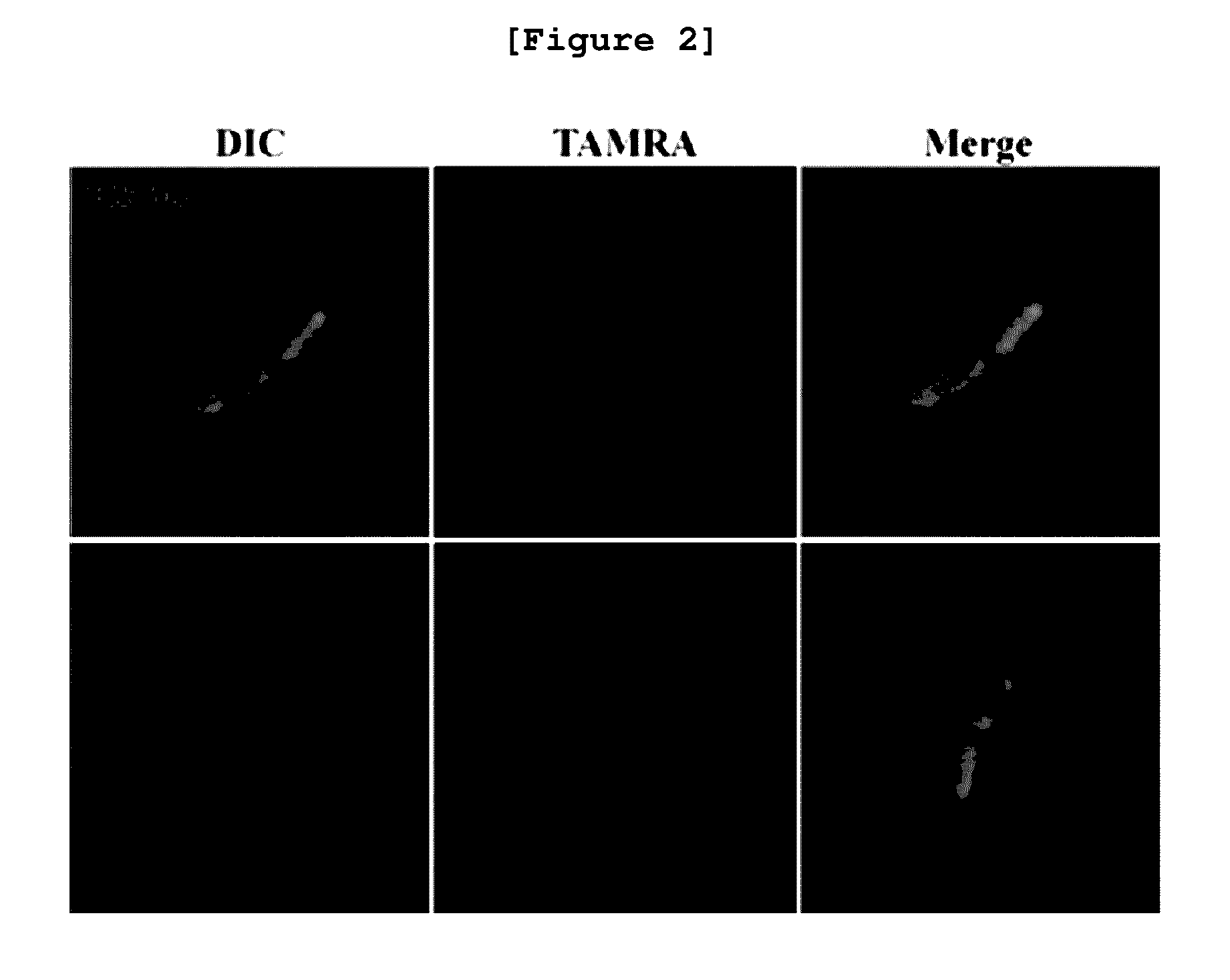Analogue Peptide CMA3 Derived from CM-MA Peptide and Use Thereof
a technology of cmma and analogue antibiotics, applied in the direction of peptides, antibacterial agents, peptide/protein ingredients, etc., can solve the problems of bacteria gaining resistance to antibiotics, and achieve excellent antimicrobial activity and low cytotoxicity
- Summary
- Abstract
- Description
- Claims
- Application Information
AI Technical Summary
Benefits of technology
Problems solved by technology
Method used
Image
Examples
example 1
Synthesis, Separation, and Purification of Peptide
[0106]The present inventors replaced the 4th amino acid of the mother peptide comprising the amino acid sequence represented by CA-MA with histidine, the 5th amino acid with lysine and leucine, and the 7th amino acid with histidine, according to the solution phase peptide synthesis method of Merrifield (Merrifield, R B., J. Am. Chem. Soc., 85, 2149, 196), and also changed the position of any of the amino acid residues in the sequence ranging from the 13th residue to the 17th residue at random, which were then replaced with histidine. The 15th amino acid of the antibiotic peptide comprising the amino acid sequence represented by CA-MA was also replaced with glutamine (Table 1).
[0107]Particularly, the peptide having the carboxyl terminal in the form of NH2 designed in this invention was synthesized by using Rink Amide MBHA-Resin as a starting material. The peptide having the carboxyl terminal in the form of OH was synthesized by using ...
example 2
Measurement of Antibacterial Activity
[0110]To compare the antibacterial activities among those peptides prepared by the method of Example 1 of the invention, the inventors measured MIC (minimal inhibitory concentration) of the peptide which is the minimum concentration for staying without being broken.
[0111]Particularly, the strains listed in Table 2 were purchased and cultured in each medium composed as instructed until the mid-log phase. The cells were diluted at the density of 5×105 cells / 100 μl, which were then inoculated in a micro-titrate plate (Nunc, USA). Then, the CMA1, CMA2, CMA3, CMA4, CMA5, or CMA6 peptide synthesized in Example 1 was ½ fold diluted in each 96 well plate, and then added to the plate, followed by culture at 37° C. for 12 hours. OD620 was measured with a micro-titrate plate reader (Merck Elisa reader, Germany) to determine MIC for each strain. As for the control, the mother peptide CM-MA was treated by the same manner as described above and MIC was also de...
example 3
Measurement of Hemolytic Activity
[0113]To compare the cytotoxicity of each peptide prepared by the method of Example 1 of the invention, the red blood cell hemolytic activity of the synthesized peptide was measured.
[0114]Particularly, human red blood cells were diluted in PBS (pH 7.0) at the concentration of 8%. The cells were treated with the peptide prepared in Example 1 (CM-MA, CMA1, CMA2, CMA3, CMA4, CMA5, or CMA6) at the concentration of 12.5, 25.0, 50.0, 100.0, or 200.0 μM / well, followed by reaction at 37° C. for 1 hour. Then, centrifugation was performed at 1,000 g. The hemoglobin content in the supernatant was confirmed by measuring OD414. For the investigation of cell destruction levels, the control cells were treated with 1% Triton X-100 (Sigma, USA), followed by reaction at 37° C. for 1 hour. Then, OD of the supernatant was measured. Considering the red blood cell hemolytic activity of Triton X-100 as 100%, the hemolytic activity of each peptide was calculated through the...
PUM
| Property | Measurement | Unit |
|---|---|---|
| Length | aaaaa | aaaaa |
| Length | aaaaa | aaaaa |
| Length | aaaaa | aaaaa |
Abstract
Description
Claims
Application Information
 Login to View More
Login to View More - R&D
- Intellectual Property
- Life Sciences
- Materials
- Tech Scout
- Unparalleled Data Quality
- Higher Quality Content
- 60% Fewer Hallucinations
Browse by: Latest US Patents, China's latest patents, Technical Efficacy Thesaurus, Application Domain, Technology Topic, Popular Technical Reports.
© 2025 PatSnap. All rights reserved.Legal|Privacy policy|Modern Slavery Act Transparency Statement|Sitemap|About US| Contact US: help@patsnap.com



